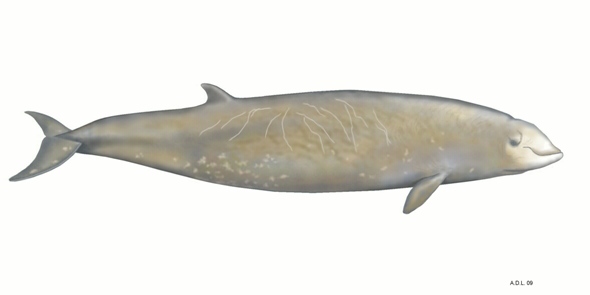Species Index


Key Facts
Length: Up to 7 metresRange: Widely distributed in tropical to cool temperate waters
Threats: Marine litter, pollution, acoustic disturbance
Diet: Mainly squid, some fish and crustaceans
Cuvier's Beaked Whale
Latin: Ziphius cavirostris
Physical Description
The Cuvier’s beaked whale is a rotund- bodied animal that can measure up to seven metres in length. It has a slightly bulbous melon, no prominent beak and a small curved dorsal fin. In adult males, two forward-pointing teeth can protrude from the tip of the lower jaw, visible when the mouth is closed. There is a slight depression in the body beneath each pectoral fin, known as the ‘flipper pocket’. Colouration is predominantly dark grey, but with a pale grey melon, light coloured lower jaw and pale patch from the melon to the dorsal fin. There is a pale grey chevron marking under the chin. Oval scars caused by parasites or predators are common in older animals, whilst scratches and tooth rakes are seen on adult males having been inflicted by other males.
Habitat and Distribution
Cuvier’s beaked whales are widely distributed throughout all major oceans but they are not found in polar seas; northern Scotland represents their northern-most limit. Live sightings in the Hebrides are very rare but numerous stranded animals indicate they may be more common than sightings data suggest. In 2008, there was a multiple stranding of Cuvier’s beaked whales in the Hebrides.
Behaviour
The Cuvier’s beaked whale is usually elusive and inconspicuous at the surface although there are several reports of breaching animals in some parts of the world. Upon surfacing, the beak normally breaks the surface first, followed by a small blow; they may raise the fluke above the water when deep-diving. Of all the beaked whales, global records show that Cuvier’s are the most frequently stranded species.
Food and Foraging
Squid form the main part of the Cuvier’s beaked whale diet, although they also consume fish and crustaceans. They can dive for over 30 minutes to reach deep-dwelling prey. Other than the pair of teeth in adult males, beaked whales are toothless and are thought to use suction to catch their prey.
Status and Conservation
There are no global population estimates for the Cuvier’s beaked whale although they are generally thought to be one of the most abundant of the beaked whale species. The main threats include the accumulation of toxic pollutants in whale tissue and organs, entanglement in fishing nets and marine litter, and noise disturbance. They may also swallow plastic bags mistaken for prey, which can accumulate in the stomach of the animal causing starvation and eventual death. Cuvier’s beaked whales are protected under UK and EU law, principally under Schedule 5 of the Wildlife and Countryside Act 1981, the Nature Conservation (Scotland) Act 2004 and by the 1992 EU Habitats and Species Directive.





